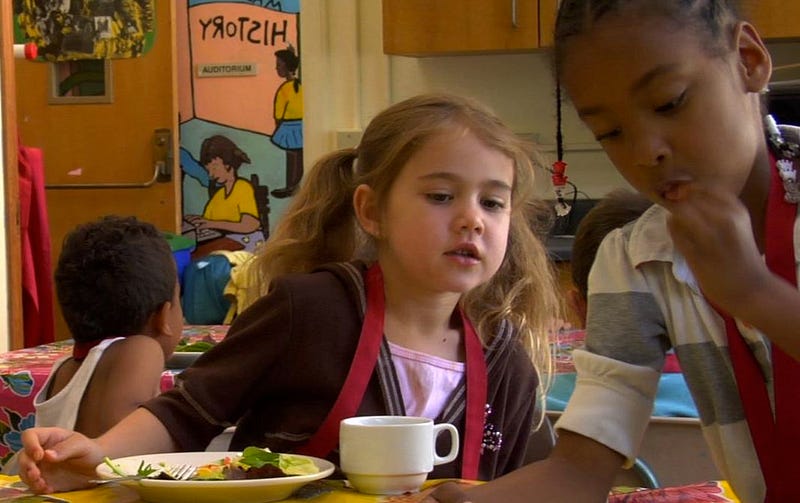 From the
documentary Lunch Love Community. Photo: Sophie
Constantinou
From the
documentary Lunch Love Community. Photo: Sophie
ConstantinouA conversation with authors Helen De Michiel and Patricia R. Zimmermann
I first met Patricia R. Zimmermann in 2004 when I was a visiting assistant professor at Ithaca College. Through her, I met many independent filmmakers, including Helen De Michiel, who was also the co-director of the National Alliance for Media Arts & Culture (NAMAC). One of my fondest memories of the two of them was going to the 5th Congreso Internacional de Teoría y Análisis Cinematográfico in Morelia (Michoacán), México, in 2009. Patty and Helen delivered a plenary talk, “The Open Space Documentary Project,” on digital documentary practice that emphasized the documentarian’s role in providing context as well as content.
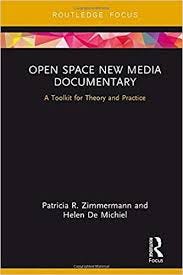
Many of the ideas in that talk developed into their new book, Open Space New Media Documentary: A Toolkit for Theory and Practice (Routledge, 2018), which I read early this summer and have more recently had the opportunity to discuss with them. The book is remarkable because it integrates documentary studies with documentary practice. They don’t fixate on formal elements or devices but instead get into how different forms can help articulate new perspectives around particular issues. In the process, they highlight place-based practices that mobilize new media to reinvigorate, if not outright reinvent, documentary.
Most of us are familiar with documentary through the old media practices of analog film and television. As audiences, we sit, watch, and listen as documentarians carefully compose narratives and arguments for us. New media adds other features, such as the possibility for us as audience members to become collaborators by reordering these narratives and arguments. We can engage in comparative analysis. We can tease out intricacies. Narratives and arguments are not fixed on celluloid and magnetic tape; instead, they are rendered on screen through user acts, such as clicking icons. Documentary is no longer static, but fluid.
Patty and Helen take this re-conception of documentary one step further by considering projects that advocate for “open space,” which is a concept used in urban planning and other fields to suggest commons—that is, spaces that have not been privatized or militarized, ones that anyone can theoretically access, utilize, and inhabit. To make a long-form documentary and then get it exhibited requires a level of resources and support that is out of reach for most of us. Commons open up new possibilities.
Taking advantage of available digital tools and circulation options, the open space new media documentaries that Patty and Helen describe provoke and encourage other perspectives to be seen, heard, and understood. These project move across analog, digital, and embodied settings to where people and technologies meet. They move out of cinemas, broadcast, cable, and satellite into everyday public gathering spaces— art and community centers, schools, libraries, hospitals—and onto mobile phones. They work towards a practice of discovery.
Dale: When did you begin to notice a critical mass of what you are defining as “open space new media” projects that helped you redefine documentary?
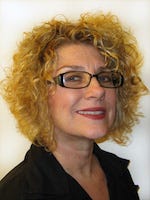
Patty: These collaborative works require a different and new theorization of the documentary project because they shift virtually all the coordinates.
Our thinking about open space new media documentary began a decade ago. As co-director of the Finger Lakes Environmental Film Festival (FLEFF) over the last 15 years, which programs across platforms, I observed a dramatic shift in documentary from fixed, closed forms toward more iterative, shape-shifting, multi-platformed projects. (And kudos to you, Dale, who as our new media curator found some of the projects in the book.)
Although we always program analog films, I witnessed a tectonic shift into a more horizontal, distributed mode designed to be open to many inputs in various forms from different kinds of people. These works flip the script of the auteurist, genre-structured long-form film toward the production of a space where people can convene to explore and unpack difficult ideas.
As a scholar, a programmer, and a professor, I’m attracted to new developments that I do not fully comprehend.
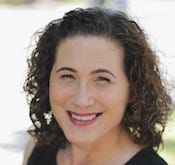
Helen: In 2008, when I was co-director of NAMAC (now, The Alliance), we were deeply involved in learning how new forms of storytelling emerging online would affect the independent media making field. Ten years ago, broadband streaming was just emerging. People blogged everywhere. Funders started to pay attention to public engagement practices in communities beyond film festivals and television screens.
Inspired and intrigued by what I was learning and seeing, I immersed myself in a new, iterative documentary project to take advantage of emerging digital platforms built for participation and exchange. In a mosaic of twelve short films of varying lengths, Lunch Love Community explored a local, pioneering food-justice movement. Through a range of stories, we took a deep look at how one community transformed its public school food program, and changed the way that children eat.
I was excited to explore how we could creatively use online spaces to deliver the films, spark curiosity among new audiences, and expand how communities could use them get people working together for better nutrition and health education.
Patty and I discovered that the new media projects that drew us in blended together unusual combinations of forms, contexts, and connections with communities finding one another on evolving online platforms and in real places. They combined documentary, narrative, and journalism in new ways.
We wanted to connect this work to an historical lineage of collaborative arts, social engagement, and community-based work. The open space framework offered a fitting conceptual lineage. It also connected these new works to design, architecture, dialogic communication, and the hidden histories of twentieth-century radical film collectives, collaborations, and participatory mediamaking experiments.
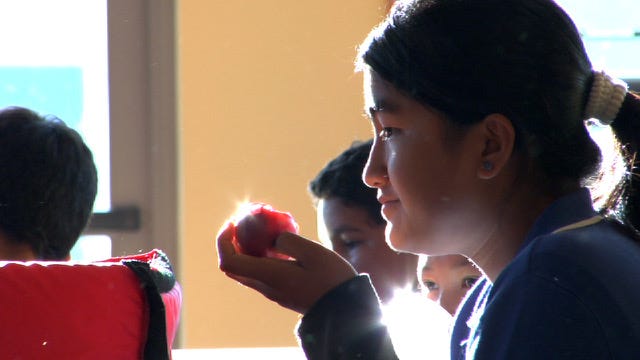 Photo
credit: Sophie Constantinou
Photo
credit: Sophie ConstantinouEarly in the book, you write that open space documentaries “act as experiments in how to think through and design dialogic approaches to political crises and traumas,” that is, they “generate open-ended ideas, questions, solutions, and actions” rather than “producing images or artifacts.”
You mention that documentary needs to contend with the reality that some stories will remain unresolved. What prompted such an insight? I’m wondering whether it emerged in part from community-based practice, particularly Helen’s Love Lunch Community.
Helen: An open space documentary work is dynamic. It is open to iterative growth and change.
The projects explored in our book complicate questions and issues rather than simplifying them. They invite the viewer-participant to take the time and effort to explore the layered thickness of the artists’ proposition or inquiry. They do not offer tidy narrative bundles aimed at entertainment. Meaning shape shifts depending on where the work is encountered, whether online, at a film festival, a community screening, or in a classroom.
Echoing other twentieth-century experimental forms, these creators foreground the discovery and growth process rather than the final product. This orientation toward process clears different pathways and makes new combinations. Because the media artifacts can easily be distributed, discussed, and developed as they are created in real time, open space media generates different questions and actions as the work evolves.
In open space documentary, makers can explore relationships that develop with the subjects and participants as co-creators from the beginning development of the project to production to bringing it out in a public sphere. In most long form documentary films, these kinds of relationship are usually repressed and not recognized.
An open space documentary work is dynamic.
Patty: We kept asking: why are these works different, and how are they designed?
I heard scholars and programmers proclaim that new media forms lack argument or a position. Intuitively, I did not agree. So many new media artists and collectives that I programmed through FLEFF addressed very contentious issues such as climate disruption, water, land, extraction, war, migration, toxicities, and displacement as spaces to investigate and complicate.
I began to wonder why I found these projects, which created new kinds of interfaces or used a combination of new technologies, so exciting and so provocative compared to long-form analog films. Although still very important for festivals and for the world, these films felt earnest and predictable in comparison.
I began to think about how these works were open in terms of how they considered production, distribution, and exhibition as permeable and ever-changing.
I really appreciated your focus on twelve projects that might ordinarily be overlooked by documentary studies because they are not theatrically screened, feature-length films. I also appreciated that many of your examples were primarily the work of women.
You were writing before Silicon Valley’s “bro culture” made international headlines, particularly after Emily Chang’s book Brotopia (2018). I’m wondering in what ways a feminist media practice informed your thinking.
Patty: Helen and I come out of decades of feminist media theory and practice. It’s our training as undergraduates in the 1970s, graduate students in the 1980s, and as people involved in public media since then in various capacities: professors, programmers, board members, executive directors, festival directors, and producers.
I’d like to say we were completely self-conscious about the focus on women, but we only discovered that feature once the book was almost done.
Feature-length theatrical films have emerged primarily as the domain of white men. There are gendered inequities in documentary and new media studies. The tech world, whether Silicon Valley or new media artists, becomes a refuge for men and their machines.
Instead of critiquing this situation, we discovered a very wide exciting world of work designed on feminist principles of collaboration, movement, equality, convenings, heterogeneous discourses, and multiple technologies. This work, privileges people, ideas and over technologies.
We discovered a very wide exciting world of work designed on feminist principles of collaboration, movement, equality, convening, heterogeneous discourses, and multiple technologies.
Helen: I have always struggled working through the gaps between my ambitions and the systemic limitations that I face as a woman working in the media world.
As these new digital platforms opened up niches for creative inquiry, I imagined these new public spaces held the potential for different forms of storytelling and distribution. Because there was so much freedom, these emerging spaces evoked feminist media-making legacies that made sense to me as a working mother, juggling multiple obligations.
For me that meant designing a project where I could practice listening to story participants and working deeply in my own community. I needed to recognize and work with my geographic and financial limitations because of family needs. I also wanted to rethink collaborative processes with feminist principles in mind while embracing the energy of the small place as valuable to explore.
In the example of Lunch Love Community, that meant observing, filming, and engaging with partners and participants in our own Berkeley neighborhoods and schools. The project was designed to come from a place of local knowledge with all its revealing conflicts, contradictions, and complications. I did not parachute into the story, I walked around the streets where I already was living and working.
As a new media project, my work on Lunch Love Community was a big surprise. As we were making it, I ended up taking the time to write and reflect about the process. I wrote blogs, articles, reports, and reflective essays on how this episodic documentary was doing its job in the world, how it was connecting to broader issues, and how it was having an impact on my own experience as a filmmaker.
This writing places the work dynamic, which took place from 2008 to 2013, within two fields of vision: the narrow lens of my own activities and insights and the wider lens of feminist media practice.
For the book, it was natural for me to be interested in work with a particular feminist sensibility that cleared out pathways similar to Lunch Love Community.
Another principle that you make throughout the book is “speaking alongside and with the subject rather than for the subject.” You draw upon David MacDougall’s notion of transcultural film, but he does not address that wide array of formats and platforms that you discuss. You emphasize horizontality of interaction and exchange as an ethical opposition to the entrenched verticality of individualism evident in documentary and essay films that garner awards at commercial film festivals such as Cannes, Toronto, and Sundance.
Could you say a little more about how open space documentary can transform “ordinary citizens into agents with valued points of view?”
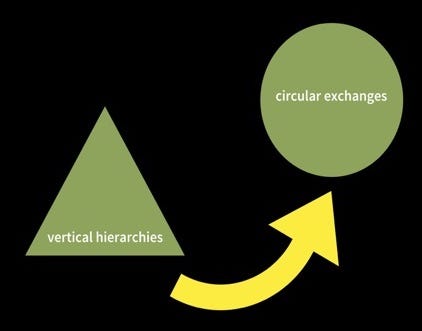
Helen: It was a powerful revelation for us when we visualized the power dynamic in the digital sphere as a circle rather than a triangle with producers and subjects at the base and audiences at the top.
The relationships among makers, subjects, and audiences flatten out into horizontal fields. Instead of the well-controlled, streamlined long-form film that ends with a resolved conclusion, these projects designed physical and virtual spaces for participants and audiences to add, subtract, and modify what was in and around the project’s media environment.
When visitors and audiences are invested in the subject, they can use the projects in new ways in their own worlds.
The media ecology that we inhabit is a mosaic of voices competing for attention. In this moment of weaponized media, the ability to open up the lens and harness collective complex perspectives will be the most striking and valuable work going forward.
How documentarians make work that gathers people together to process complicated questions and experiences is the life-affirming energy of open-space documentary our book explores.
People want their life experiences to be recognized and understood. They do not want to be used as characters in a movie’s narrative. In contrast, open-space new media documentary uses a multilayered, nonlinear, reflective, and active approach designed for exchange and sharing of aspirations, emotions, and sensibilities among participants.
When co-creative collaborators work together in a slow process of developing and becoming, the kind of deeper dialogues that we value surface.
The relationships among makers, subjects and audiences flatten out into horizontal fields.
Patty: Most documentary consolidates, translates, persuades, and explains situations. Open-space new media documentary works design across platforms. They create new territories for urgency, disorderliness, and heterogeneity. These works do not close down and limit, but create locations for speaking alongside in various horizontal formations.
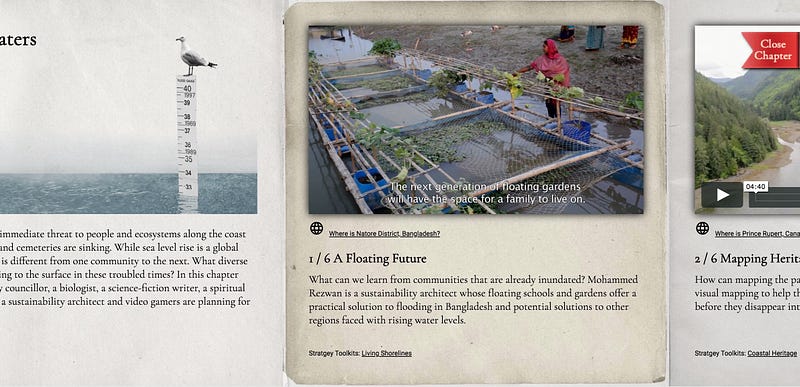 The
Shore Line
The
Shore LineIn your discussion of Elizabeth Miller’s The Shore Line as responses to the violence of climate change, you mention that the project’s multilayered storytelling “displays points of convergence” that can “encourage self-reflection and creative response.”
In your discussion of Dorit Nauman’s Jerusalem, We Are Here as responses to the violence of Israel’s ongoing erasure of Palestinian, Armenian, Greek, and other non-European histories in Al Quds (Jerusalem) since the Nakba, you cite the project’s recovery of “home movies” as “citizen journalism.”
How can documentarians ensure that urgent questions reach audiences invested in thinking together for climate and political justice?
Patty: The question of how to reach and engage audiences is a key operating principle and an ongoing question in open-space documentary. In these works, exhibition and audiences are never assumed.
Elizabeth Miller selects different pieces from The Shore Line for different settings [when she exhibits the project]. She looks for resonances and then opens up discussion in between the short pieces. Dorit Naaman uses the tours imbedded in Jerusalem We Are Here as a model for guiding audiences through her project.
Open-space media challenges festival programmers and museum curators. It’s quite different than simply showing a film followed by a moderated Q&A.
As a programmer, I have to collaborate with the makers to figure out who can moderate this type of encounter. The moderator needs to establish context, bring out ideas, and invite the audience into the work in a different way that the festival auteurist model.
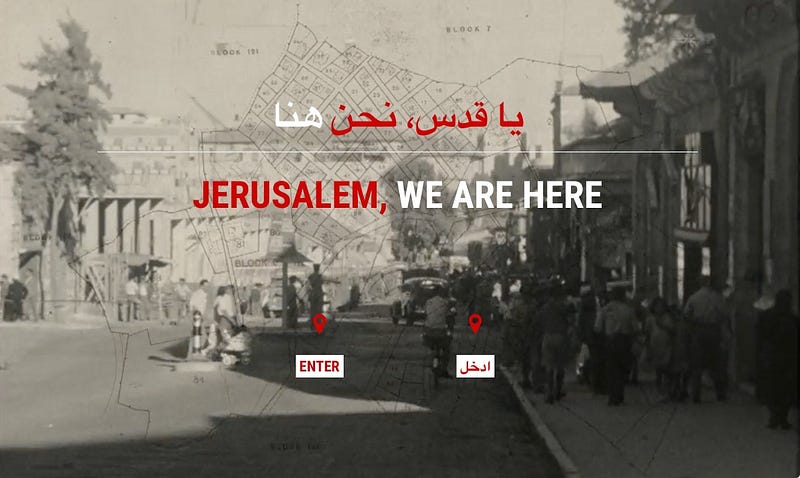
Helen: In my experience as a director/producer/artist, this happens through intentionally reaching out to and partnering with people, both as individuals and in groups, who want to practice dialogue for change beyond partisan conflict. Points of convergence happen when we listen for ambiguity, nuance, and emerging contradictions. They form the mosaic structure of the work.
In our book, we discuss ten working principles to produce this kind of open space work. These principles give makers and researchers a toolkit to anchor a process.
These principles are:
- circularity: a responsive and adaptive exchange among collaborators
- collaboration: necessary activity for co-creation and iteration
- community: what we are building in a real place
- complexity: applying design thinking across forms
- composting: artifacts in flux of loss and renewal
- connection: seeding empathy across boundaries
- context: finding places for growth and change
- continuum: where we are in our participatory process
- conversation: designing for transformational dialogue
- cost: estimating, improvising, and adapting
I found that your chapter on polyphonic collaborations made productive connections between digital structures and radical historiography. That is, open-space documentaries allow user to recombine data into information that often contradicts official histories and narratives.
The idea of layering additional stories to reveal the contours of incredibly complex political and social situations is powerful. Historiography becomes activism.
One possible concern is that people may be intimidated from participating in such projects due to the potential use of user-generated content as evidence by repressive regimes or societies. You mention it in relation to the women subjected to forced sterilization who contributed to Maria Court and Rosemarie Lerner’s The Quipu Project. What strategies are new media documentarians utilizing to assure participants of protections?
What strategies are new media documentarians utilizing to assure participants of protections?
Patty: The question of participation and protection is very complex in these works. As both a concept and a practice, participation is variegated and multiple, ranging from wandering around in a site, to being part of the design process, to sharing stories, to joining a convening, to observing, to working as a co-creator.
Participation migrates across concept, design, production, distribution, and exhibition — a continual circle of enactment and shape-shifting forms. Because many topics pose threats to participants, open-space new media designers need to always think through the conjunctions of small spaces, contentious social and political situations, and risks posed to participants.
Technologists —who think through how technologies can be designed and reverse-engineered to solve problems in a sustainable way — become key players in open-space new media, a major difference from analog documentary.
The Quipu Project confronted the question of Quechua speaking women in remote areas who had been sterilized and then silenced. They lived in regions without internet access.
The project’s goal was to collect testimony to be used to achieve justice in Peru for these women who endured these operations. Inexpensive phones were designed that facilitated women calling into a number to share their stories anonymously.
But technology was not operating alone — the Quipu producers collaborated with various feminist legal and support groups in Peru to mount many embodied convenings to discuss the project and the sterilizations.
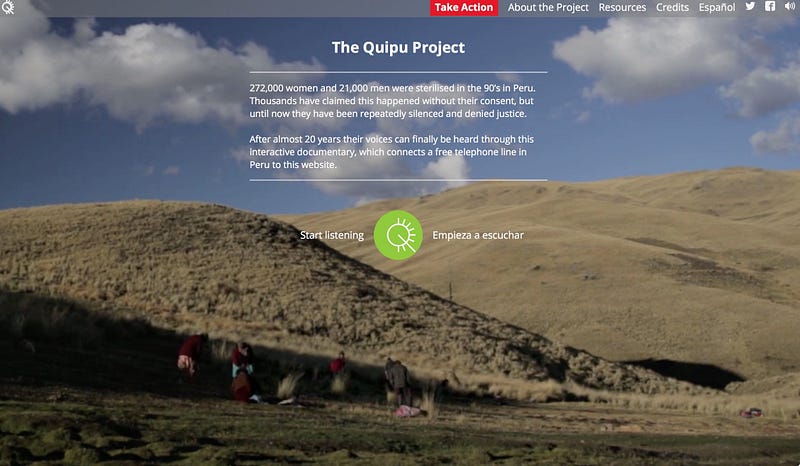
Helen: Is protection really possible now?
I think we need to imagine and use different approaches towards building an awareness of media literacy among project participants. We honestly need to prepare people who choose to work with us for what it means to go public with their stories and experiences, and how meaning-filled — rather than fear-filled — those revelations will be.
Patricia R. Zimmermann is Professor of Screen Studies at Ithaca College (USA) and codirector of the Finger Lakes Environmental Film Festival (FLEFF). She is the author and editor of numerous books, including Thinking Through Digital Media: Transnational Environments and Locative Places with Dale Hudson (2015), Open-Spaces: Openings, Closings, and Thresholds of International Public Media (2016), The Flaherty: Decades in the Cause of Independent Film with Scott MacDonald (2017), and Open-Space New Media Documentary: A Toolkit for Theory and Practice with Helen De Michiel (2018).
Helen De Michiel is a filmmaker, new media artist, author, and educator. Her feature narrative and documentary, installations, and transmedia works have earned her a Rockefeller Intercultural Media Fellowship and several NEA awards, among other awards. Along with Patricia R. Zimmermann, she co-authored Open -Space New Media Documentary: A Toolkit for Theory and Practice (2018). She teaches at California College of the Arts. She is a 2018 Fulbright Digital Media Specialist and is currently working on a new documentary, Knocking On Doors.
Dale Hudson is an associate professor in the Film and New Media Program at New York University Abu Dhabi (UAE). He is author of Vampires, Race, and Transnational Hollywoods (2017) and co-author with Patrica R. Zimmermann of Thinking through Digital Media: Transnational Environments and Locative Places (2015). He curates online exhibitions for the Finger Lakes Environmental Film Festival (FLEFF) and coordinates submissions from the Gulf for the Middle East Studies Association (MESA) film festival.
Immerse is an initiative of the MIT Open DocLab and The Fledgling Fund, and is fiscally sponsored by IFP. Learn more about our vision for the project here.